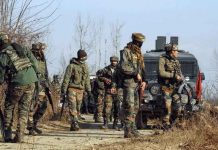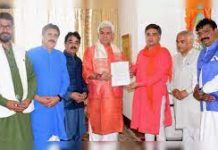With the Congress spelling out its political and socio-economic vision at the 85th
Plenary Session held at Raipur, many of the regional satraps seem to be inclined to come under the umbrella of the grand old party to take on the BJP
The 85th Plenary Session of the Indian National Congress, which recently concluded in Raipur, Chhattisgarh, was held at a time when the Bharat Jodo Yatra (BJY) had reached its destination, and the baton of Congress presidency was formally passed on to Malika Arjun Kharge from the Gandhi family after a hiatus of 25 years.
The 1998 Panchmari Session of the Congress had adopted the strategy of Ekla Chalo’(walk alone), while the BJP was gaining popularity in the Hindi Heartland, and Congress at that juncture didn’t deem the rising BJP as a potential threat and also ruled out the politics of coalition. However, after suffering an electoral drubbing in 1999 which brought the NDA (National Democratic Alliance) headed by the BJP at the helm, Congress had to do rethinking at the Shimla session of Congress in 2003 where it mooted the idea of forming a coalition of like-minded parties and the resultant outcome was the formation of a coalition government under the aegis of Congress and known as the UPA (United Progressive Alliance) which remained at the helm at the Centre and in many states as well.
The sudden rise of the BJP under the leadership of Narendra Modi and its handsome victory in the 2014 Lok Sabha elections brought NDA at the helm of affairs at the Centre and in many states while Congress was humbled at the hustings and reduced to a limited number of seats in Lok Sabha and even had failed to garner enough seats to be acknowledged as the leading Opposition Party. The 2019 elections to the Lok Sabha witnessed the BJP securing a landslide victory with Congress registering a minuscule gain in its total tally but still lagging behind to be acknowledged as the leading Opposition Party in the House.
The period from 2014 to 2022 witnessed an incessant blitzkrieg campaign launched by the BJP against the Congress and Rahul Gandhi raising slogans like ‘Congress-Mukt-Bharat’ and alluring the elected representatives of Congress in Congress-ruled states to the BJP fold to form the BJP-led governments in those states and using the national media to denigrate the image of Rahul Gandhi. Measures like demonetization and electoral bonds proved instrumental in drying up the financial resources of the Opposition parties, especially the Congress. Recurring incidents of humiliating drubbings at the assembly elections and desertions of many local/regional leaders to the BJP fold in some states and no hope of political revival in the immediate future left the party and organization in disarray.
In the wake of these discouraging developments, the top brass of the party had to embark upon some revolutionary programme that could prove instrumental in revitalising the party, boosting the morale of party workers at the grassroots level and winning the confidence of the people in the party’s programmes and policies, and the Udaipur session of Congress charted a programme for the party emphasising embarking on a nationwide padayatra to commence from 2 October 2022.
Consequently, Rahul Gandhi took the initiative of launching the Bharat Jodo Yatra (BJY) from Kanyakumari to Srinagar, and the BJY started on 7 September 2022 from Kanyakumari and culminated on 30 January 2023 at Srinagar in Jammu and Kashmir covering over 4000 km. During the course of over 150 days of the BJY, Rahul Gandhi often reiterated at press conferences that the BJY was not an electoral exercise, not even for the Congress, the BJY was an exercise to invent India and to protest the politics of “fear, bigotry and prejudice”, and the growing economic inequality. In his final speech at Srinagar on 31 January 2023, Rahul Gandhi talked of “Ganga-Jamuni tehzeeb”, of the sages of ancient India and the language of love, and held the BJP-RSS combo responsible for the “violence, communal disturbances and the hatred” in the country as well as the destruction of the economy.
While commenting on the outcome of the BJY, some political observers ask what Rahul Gandhi expected to gain from the BJY if not electoral victory or organisational resurgence. However, some experts believe that Rahul Gandhi does not appear to be in a rush to win elections and that he is instead focusing on long-term benefits for Congress’s rehabilitation in the eyes of the public. Another group of experts argue that much depends on the performance of the Congress in the forthcoming nine state assembly polls and if the Congress performs well in these polls, it will be a by-product of the BJY. For these experts, the avowed objective of the walkathon – the BJY – is to build the discourse and momentum for Congress in the long run.
Rahul Gandhi’s BJY has the potential to accomplish for the Congress and the country what L.K. Advani’s Rath Yatra did for the BJP and the country in the 1990s, but with the exact opposite result. Contending that if Advani’s Rath Yatra could sow the seeds of Hindu nationalism in India, some experts opine that Rahul Gandhi’s BJY entails the potential of strengthening inclusivity and project the Congress as the only force capable of doing that. While Rahul Gandhi has pointed out multiple flaws in the BJP’s socio-economic, defence and foreign policies, the Raipur Session of the Congress has also offered an alternative model and vision to administer the country.
Undoubtedly, the Congress has spelt out its socio-economic and political vision at the Raipur session; nonetheless, the real test lies ahead in how far the party workers can carry out the message of this vision to the grassroots level to win the trust of the masses. The better way to judge this would be the outcome of forthcoming elections to state assemblies of Chhattisgarh, Karnataka, Madhya Pradesh and Rajasthan, and for this Congress has to gear up its organisation wherewithal at the state, district and village level.
Rahul Gandhi leading the BJY from the front has enabled the Congress to showcase that the party is capable of a sustained public outreach programme on the ground, and the BJY has successfully completed after travelling through 13 states and one Union Territory, demonstrating the logistical and organizational skills of the Congress state units, even in states where the party is not in power. Rahul Gandhi’s reputation has successfully changed as a result of the BJY from a reluctant and part-time politician to one who can take to the streets when necessary and has the stamina to walk the distance.
Some experts opine that the grassroots workers and the Congress organization have been greatly motivated by the BJY and they now have renewed faith in Rahul Gandhi, the tallest of their leaders, who had started to lose it after two straight defeats in the Lok Sabha and numerous state failures. Some experts also feel that Rahul and Congress must work to maintain the momentum created by the BJY.
The BJY has enabled Congress to reposition itself as the only national opposition force opposing the Prime Minister Narendra Modi-led BJP. Despite the Congress’ invitation, other prominent Opposition figures like Mamata Banerjee, Nitish Kumar, Akhilesh Yadav, Tejashwi Yadav, and Sharad Pawar declined to attend the BJY’s conclusion in Srinagar. Nevertheless, during the yatra, the civil society groups that are opposed to the BJP-RSS system joined forces under the leadership of Congress.
In the post-BJY period, when the Congress has spelt out its political and socio-economic vision at its Raipur session recently, many of the regional satraps seem to be inclined to come under the umbrella of the Congress to forge a united Opposition front to defeat the mighty BJP in the ensuing state assembly polls in 2023 and 2024 general elections. Bihar-style Mahagathbandhan comprising seven non-BJP parties offers a role model for the national level alliance of non-BJP opposition parties, including the Congress. The Congress has positively responded to Bihar Chief Minister Nitish Kumar’s call for such national alliance of non-BJP opposition parties.
The Congress in its new avatar entails the potential of uniting the regional satraps under its umbrella and much depends on the party’s electoral performance in the ensuing assembly polls due this year.
( By DR Anil Singh, Executive Editor, India Ahead News Channel, was recently in Raipur)











